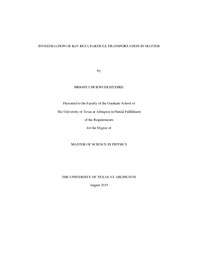| dc.description.abstract | Nuclear imaging is widely used in medicine for more accurate diagnoses and more effective treatment for cancer. Current emission tomography techniques used in clinics may not efficiently detect cancer at a very early stage partly because of the weak signals from small tumors. Portable nuclear imaging devices can more effectively reveal these small tumors in a close proximity for complete malignant tissue destruction. With the advance of detector technology in high energy physics, the detection of beta particles (positron and electron) from clinical/pre-clinical radiotracers, such as those labeled with Cu-64, may open a new avenue for imageguided treatment of cancer. In this research we use a high energy particle transportation Monte Carlo simulation toolkit (Geometry And Tracking – 4: Geant4) to simulate Beta particles propagating through matter. To demonstrate how beta particles with the energy of interest transport in human soft tissues and interact with materials used in a gas electron multiplier detector, we simulate electrons and positrons with the energy spectrum of 64Cu (half-life of 12.7 hours; 17.8% β+ decay with the maximum energy of 0.653MeV; and 38.4% β− decay with the maximum energy of 0.579MeV) traveling through water (mimicking human soft tissues) and four other materials (air, iron, kapton, and beryllium). We summarized the profiles of beta particles tracks, ionization patterns, and path lengths a electron beam at 579 KeV and a positrons beam at 653 KeV propagating through aforementioned materials. Tracks of these particles were collected in a step size of 0.05 mm in our simulation with the beam source located at the center of a 1cm x 1cm x 1cm cube full of one type of material. The ranges of beta particles in these materials were also summarized. The beta particles emitted from Cu-64 have a long range in air and are only able to penetrate 1-2 mm of water. Kapton is a better material for detector window than iron or beryllium in terms of less attenuation of the beta particles. This study provided the preliminary data to guide the next step of development of a portable nuclear imaging device and imaging experiments. | en_US |

